"The Find Of The Decade"
by Bob Alexander
Reprinted from "Crown Jewels of the Wire", July 1994, page 17
Recently I was at the Webster Flea Market looking for deals on insulators.
As I was walking through the booths, I thought of a few past finds. Ten years
ago I had come across a Hemingray-9 one half clear, one half blue for ten cents.
The only white milk glass H.G. Co. beehive known was found there about twelve
years ago. I kept thinking that maybe today would be the day that something
significant would turn up. There were insulators, but only "clunkers",
meaning they weren't of real value.
As I continued my walk, I stopped at a booth
and asked the man if he had any telegraph items for sale. He promptly replied
that he had found an insulator in the basement of his home which was build in
1849. I asked him to describe the piece. His description made me think that he
might have a "House" insulator, invented by Royal House, which dates
back to 1847. He also told me that he had done some research on his home and in
the process had discovered there was a possibility the insulator may have come
from a private telegraph line used by one of the former owners. His theory was
that the telegraph line ran to a town approximately ten miles away and was used
to communicate with a relative.
At that time the "House" system would
have been very practical as it printed the message on paper and anyone could
send or receive messages on it and one did not have to learn any codes. Later, I
found there was no private line but the insulator he found uses the
"House" principal, in that it has an iron shell with glass inside and
it is made to screw into a pole.
I asked the man what he would take for the
insulator and promptly paid him. He said when he returned home in March he would
send it to me, which he did.
When the package arrived, I was intrigued by what
was inside. I had never seen any insulator like it and knew immediately it was
an early piece. It had, indeed, used the "House" principal as it was
glass with an iron cover and I was aware that "House" had two patents
in 1847 and 1852. It occurred to me that perhaps this was the first
"House" insulator used (1847) and that later House used a different
insulator when he applied for his other patent in 1852. But, unfortunately, I
couldn't confirm anything.
So, I made the decision to go North to find out what
I could for myself. When I arrived, I spoke to everyone about the private line theory
and came to the conclusion that there was no private line. The only other option
was that the insulator came off the railroad. The railroad did run only a couple
of miles away from the house. The problem was determining what telegraph company
went through there at that time. I spoke to a number of people and finally at
one of the local historian's home a book called "A History of Lawrence
& Franklin Counties, 1853" was found containing the following
information: "In the summer of 1851 the Vermont and Boston Line originally
intended to extend only as far as Burlington, was continued on to Rouse's Point
and Ogdensburgh, partly along the line of the railroad and partly along the
highway. It has stations for receiving and transmitting intelligence at
Ogdensburgh, Canton, Potsdam, North Potsdam, Malone, and Chateaugay. These lines
are operated on the principle of Bain's electrochemical telegraph, and sufficient
stock was taken up along the routes to defray the expense of erection."
After several more days of fruitless searching, I returned home. A book I had
ordered from my local library, on the chance it might be of some help, had
arrived during my absence. This book, "The Telegraph in America", by
James D. Reid, was originally published in 1879 and proved to be great help.
There is a chapter on the Vermont and Boston Telegraph Company which says:
"Before the company commenced operations, the Morse system was presented
by Henry F. Rice, and the Bain system by Professor G.W. Benedict, a citizen of
Burlington. Professor Benedict, who had the advantage of a local reputation,
offered to construct the lines projected under the act of incorporation, under a
contract for $212 per mile, one third of which to represent the cost of title in
the Bain patent, and to be paid in stock. The offer of Prof. Benedict, after
some discussion, was preferred, and a contract based upon it promptly executed.
On March 21,1850, Prof. Benedict reported the line completed from Boston to
Lowell, Nashua, Manchester, Concord, Woodstock, Northfield, Montpelier to
Burlington. On this report the officers of the Company engaged Messrs. E.
Stevens, of Franklin, and Moses G. Farmer, the latter widely known as an
educated and practical electrician, to make a thorough examination of the whole
line and offices, before the acceptance of the line from the contractor.
These
gentlemen reported April 24, 1850, that "the line was well and substantially built; that the wire was of No.8, of the highest quality of
Swedish iron, and of great tenacity; and that the insulator used was the
invention of the contractor, was the best of any yet produced, and, being
covered with iron, was proof against injury. The insulator of Prof. Benedict was
no doubt honestly praised by Mr. Farmer. It was, like the House insulator, glass
molten in an iron shell, with a hook suspended in the glass. But experience soon
caused its removal, and iron no longer forms a part of any approved American
insulator. The committee reported, also, the machinery as being of a new
pattern, of superior workmanship, and very elegant. The poles were of oak,
chestnut, cedar, spruce, and hemlock. The line was worked from Boston to
Burlington with three troughs of twelve pairs each of the "sand
battery."
I was thrown off track somewhat when it mentioned a
"hook". If it was like the "House" insulator it would not
have a hook but a rod or center bar. Reading on, I discovered a few chapters
later that it mentions Mr. Farmer again.
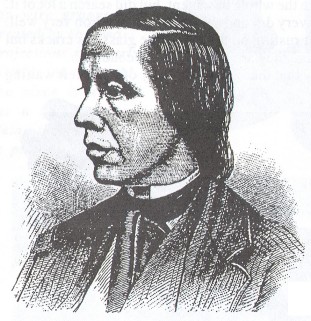
Moses G. Farmer
"The introduction of gutta percha also greatly stimulated the hope that
a basis for a perfect and permanent insulation had been found. Especially was
this so when John M. Bachelder and Moses G. Farmer began the construction of
insulators from vulcanite or bone rubber."
So it seems that Farmer and Batchelder were in business together. From this
information I feel it would be easy to assume that Batchelder took a look at my
insulator and patented his improved design in 1851. He even says in his patent
"The cup (iron shell), the glass and the center bar (not hook) were
commonly known and used." Based on this information I believe what I have
was used on the Vermont and Boston Telegraph Line in 1848 and the inventor was
Prof. G. W. Benedict, of Burlington, Vermont.
The information ranks the
insulator with some of the earliest attempts. It puts it in a class with the
"Little insulator", the Glass Block, Bureau Knob, "House"
insulator, the Gutta Percha insulator, the Brimstone insulator, the Lefferts
Hook and the Batchelder. The fact that it was not patented and I was still able
to find out who invented it was, to me, quite remarkable.
Now, for the amazing
part of my story! While I was visiting the gentleman, who sold me the insulator,
we made a trip to his basement and while exploring, found THREE more! We
couldn't get through the whole basement, but did search a lot of it. The
basement was very dry and this preserved the iron very well. There is just a
light rusting on the iron. The glass has cracks but considering their age they
are in remarkable condition.
It just shows that there are still plenty of items
left waiting to be found.
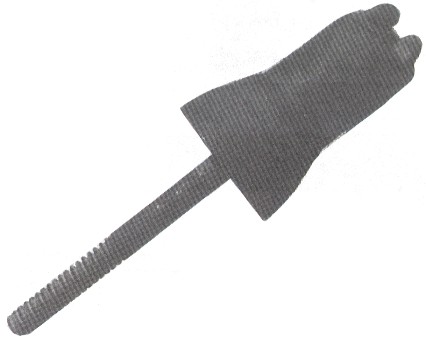
|
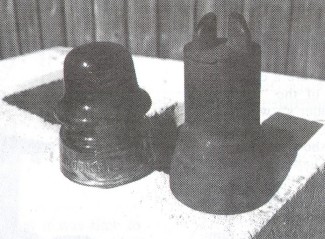 |
| The photo above shows a CD 162 Brookfield next to the
ironclad for size
comparison. The top wire groove slot created by the two projections is clearly
visible. At the right, the piece is seen after a quarter turn. Below the glass
insert is pictured. |
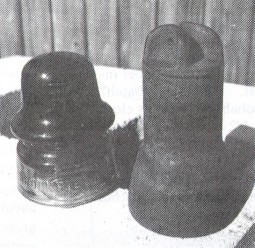 |
|

|
An interesting comparison to this newest early telegraph ironclad is the
following information sent by Mike Guthrie, Crown Jewels of the Wire West Coast
Correspondent:
Here are a couple of photos of the "batch of Batchelder's" which
arrived at the Auburn, California show last December. They represent, I believe,
all known styles: one suspension; and two screw spikes. The close-up photo shows
the ramshorn type of wire securing attachment. This is very rare! The piece on
the right shows split iron shell with hard rubber insert. This one
"batch" probably represents close to 1/2 of the total known specimens.
Can't wait to see what turns up at the Western Regional Show August 6th and 7th!
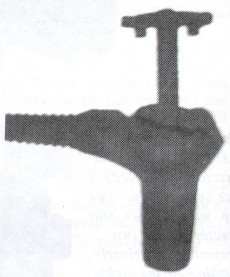

|
